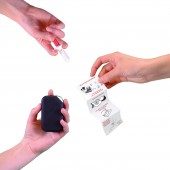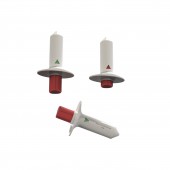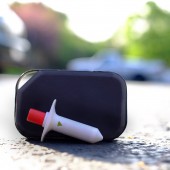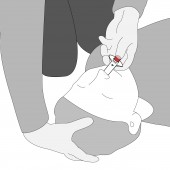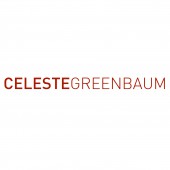Nalox Opioid Overdose Kit by Celeste Greenbaum |
Home > Winners > #68825 |
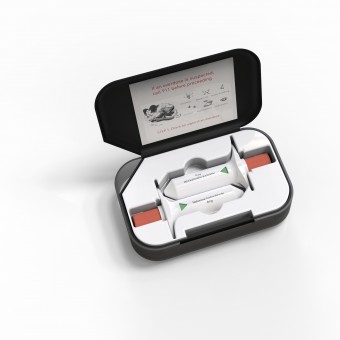 |
|
||||
| DESIGN DETAILS | |||||
| DESIGN NAME: Nalox PRIMARY FUNCTION: Opioid Overdose Kit INSPIRATION: At only 22 years old, my best friend lost his life to an opioid overdose. He isn't the only one. In America it is estimated that 175 people die a day from opioids. In my extensive research, I found that the most likely person to find an overdose victim is a loved one or passerby, but current naloxone kits (a drug that reverses an overdose if delivered quickly) have not been designed with this user in mind. I realized that by designing a naloxone kit that was easy to use and small enough to carry at all times, I could get naloxone in more hands and ultimately save more lives. Being the loved one of an addict is a very powerless situation, but carrying naloxone gives them some of that power back. UNIQUE PROPERTIES / PROJECT DESCRIPTION: Naloxone is a drug that can instantly reverse an opioid overdose if delivered quickly. Research proves that the loved ones of addicts are typically the first to find an overdose victim, but all currently marketed naloxone delivery systems are too large to carry all the time and designed with medical professionals in mind. By the time that EMT’s arrive it is usually too late for the victim, so a loved one being able to deliver this antidote is key to saving them. Naloxone is safe and easy to deliver, and is legal for anyone to use. My design is different because it was designed specifically with civilians in mind. It is discreet, intuitive, simple, and small enough to slip into a bag or put on a keychain. It encourages the user to keep naloxone with them at all times so that they are prepared and able to save their loved ones life. By getting naloxone in more hands, we can greatly reduce the number of opioid overdose deaths worldwide. OPERATION / FLOW / INTERACTION: Nalox is a better opioid overdose kit than current solutions because it is small, discrete, and easy to use. The user would keep it in their purse, put it on a keychain, or leave it in their glove compartment, where it would go relatively unnoticed until needed. If they were to encounter an overdose victim, they would unlatch the box, unfold the instructions, and follow the simple steps. This would be a stressful situation, so the simplicity and intuitiveness of the design is key to its success. Nalox puts the power to save a life in everyone’s hands. PROJECT DURATION AND LOCATION: The project started in January 2018 and ended in May of 2018. It was my senior thesis at Virginia Polytechnic and State University. FITS BEST INTO CATEGORY: Social Design |
PRODUCTION / REALIZATION TECHNOLOGY: I started by surveying 200 people, than conducted more extensive interviews from that pool of people. I also researched the problem and current solutions thoroughly. Next, I started creating forms with 3D printing and foam and brought them to users to test in a use study. This eventually narrowed me down to the final form. If this product were to be produced, the nebulizer would be made from injection molded PLA, and the case would be silicone and hard rubber. SPECIFICATIONS / TECHNICAL PROPERTIES: Box: 57.5 x 98 x 23.5mm Nasal Spray: 68 x 35(at widest point) x 17.7mm TAGS: narcan, naloxone, opioid crisis, overdose, overdose kit, heroin, opioids RESEARCH ABSTRACT: I conducted research for this project through surveys, interviews, and literature analysis. My survey received 200 answers. I asked their opinions on the opioid crisis and if anyone they knew struggled with addiction. After explaining what naloxone does, I asked how much they would pay for it, and if they would agree to carry it. 98% said they would carry naloxone if the design could be improved to fit their needs. I then contacted people who had experience using naloxone and interviewed them throughout the design process. My research indicated that my idea was viable and important, and my interviews and user testing with 3D printed prototypes helped steer me in the direction of the right form, experience, and system for my overdose kit. CHALLENGE: One of the biggest challenges I faced in the realization of this product was overcoming the social stigma surrounding drug addiction and overdoses. By designing the naloxone kit in an empathetic and understandable way, and raising awareness about the truth of addiction through the website, I started to tackle these problems head on. The Nalox kit is designed in a way that does not look medical on the outside, and brings a more human feeling to a difficult situation. As far as external factors that impacted this design, the technology for intranasal naloxone is already FDA approved, so the challenge was simply to change the user experience and expand access to Nalox as much as possible. ADDED DATE: 2018-06-15 22:05:40 TEAM MEMBERS (1) : IMAGE CREDITS: Main image: Celeste Greenbaum, 2018 Optional Image #1: Celeste Greenbaum, 2018 Optional Image#2: Celeste Greenbaum, 2018 Optional Image #3: Celeste Greenbaum, 2018 Optional Image #4: Celeste Greenbaum, 2018 PATENTS/COPYRIGHTS: Copyright Celeste Greenbaum 2018 |
||||
| Visit the following page to learn more: https://bit.ly/2GeqIBv | |||||
| AWARD DETAILS | |
 |
Nalox Opioid Overdose Kit by Celeste Greenbaum is Winner in Social Design Category, 2018 - 2019.· Press Members: Login or Register to request an exclusive interview with Celeste Greenbaum. · Click here to register inorder to view the profile and other works by Celeste Greenbaum. |
| SOCIAL |
| + Add to Likes / Favorites | Send to My Email | Comment | Testimonials | View Press-Release | Press Kit |

